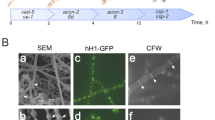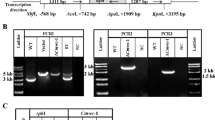Abstract
We previously demonstrated that the nop-1 gene encodes a putative green-light opsin photoreceptor that is highly expressed in cultures that support asexual sporulation (conidiation) in Neurospora crassa. In this study, we demonstrate that nop-1 is a late-stage conidiation gene, through analysis of nop-1 transcript levels in wild-type strains and mutants blocked at various stages of conidiation. nop-1 message amounts are similar with constant illumination or darkness during conidiation, consistent with developmental, but not light, regulation of nop-1 expression. Furthermore, photoinduction experiments using wild type and mutants defective in components of the blue light sensing pathway (wc-1 and wc-2) indicate that nop-1 mRNA levels are not appreciably affected by brief light exposure during conidiation. Surprisingly, nop-1 message amounts are greatly elevated in wc-2 mutants in light or dark, suggesting that the wc-2 gene product regulates nop-1 expression in a light-independent manner. Analysis of expression patterns for al-2, con-10 and con-13, genes regulated by conidiation and/or blue light, showed that nop-1 has significant and reproducible effects on all three genes during various stages of conidiation. The results suggest that NOP-1 directly or indirectly modulates carotenogenesis and repression of conidiation-specific gene expression in N. crassa.




Similar content being viewed by others
References
Bailey LA, Ebbole DJ (1998) The fluffy gene of Neurospora crassa encodes a Gal4p-type C6 zinc cluster protein required for conidial development. Genetics 148:1813–1820
Bailey-Shrode L, Ebbole DJ (2004) The fluffy gene of Neurospora crassa is necessary and sufficient to induce conidiophore development. Genetics 166:1741–1749
Ballario P, Vittorioso P, Magrelli A, Talora C, Cabibbo A, Macino G (1996) White collar-1, a central regulator of blue light responses in Neurospora, is a zinc finger protein. EMBO J 15:1650–1657
Bell-Pedersen D, Dunlap JC, Loros JJ (1992) The Neurospora circadian clock-controlled gene, ccg-2, is allelic to eas and encodes a fungal hydrophobin required for formation of the conidial rodlet layer. Genes Dev 6:2382–2394
Bell-Pedersen D, Shinohara ML, Loros JJ, Dunlap JC (1996) Circadian clock-controlled genes isolated from Neurospora crassa are late night- to early morning-specific. Proc Natl Acad Sci USA 93:13096–13101
Bergo V, Spudich EN, Spudich JL, Rothschild KJ (2002) A Fourier transform infrared study of Neurospora rhodopsin: similarities with archaeal rhodopsins. Photochem Photobiol 76:341–349
Berlin V, Yanofsky C (1985a) Isolation and characterization of genes differentially expressed during conidiation of Neurospora crassa. Mol Cell Biol 5:849–855
Berlin V, Yanofsky C (1985b) Protein changes during the asexual cycle of Neurospora crassa. Mol Cell Biol 5:839–848
Bieszke JA, Braun EL, Bean LE, Kang S, Natvig DO, Borkovich KA (1999a) The nop-1 gene of Neurospora crassa encodes a seven transmembrane helix retinal-binding protein homologous to archaeal rhodopsins. Proc Natl Acad Sci USA 96:8034–8039
Bieszke JA, Spudich EN, Scott KL, Borkovich KA, Spudich JL (1999b) A eukaryotic protein, NOP-1, binds retinal to form an archaeal rhodopsin-like photochemically reactive pigment. Biochemistry 38:14138–14145
Borkovich KA, et al. (2004) Lessons from the genome sequence of Neurospora crassa: tracing the path from genomic blueprint to multicellular organism. Microbiol Mol Biol Rev 68:1–108
Brown LS, Dioumaev AK, Lanyi JK, Spudich EN, Spudich JL (2001) Photochemical reaction cycle and proton transfers in Neurospora rhodopsin. J Biol Chem 276:32495–32505
Brown LS, Jung KH (2006) Bacteriorhodopsin-like proteins of eubacteria and fungi: the extent of conservation of the haloarchaeal proton-pumping mechanism. Photochem Photobiol Sci 5:538–546
Carattoli A, Kato E, Rodriguez-Franco M, Stuart WD, Macino G (1995) A chimeric light-regulated amino acid transport system allows the isolation of blue light regulator (blr) mutants of Neurospora crassa. Proc Natl Acad Sci USA 92:6612–6616
Corrochano LM, Lauter FR, Ebbole DJ, Yanofsky C (1995) Light and developmental regulation of the gene con-10 of Neurospora crassa. Dev Biol 167:190–200
Davis RH (2000) Neurospora: contributions of a model organism. Oxford University Press, New York
Davis RH, Serres FJd (1970) Genetic and microbiological research techniques in Neurospora crassa. Methods Enzymol 71A:79–143
Dunlap J, Loros J (2006) How fungi keep time: circadian system in Neurospora and other fungi. Curr Opin Microbiol 9:579–587
Dunlap JC et al (2007) Enabling a community to dissect an organism: overview of the Neurospora functional genomics project. Adv Genet 57:49–96
Ebbole DJ (1996) Morphogenesis and vegetative differentiation in filamentous fungi. J Genet 75:361–374
Ebbole DJ (1998) Carbon catabolite repression of gene expression and conidiation in Neurospora crassa. Fungal Genet Biol 25:15–21
Fan Y, Shi L, Brown LS (2007) Structural basis of diversification of fungal retinal proteins probed by site-directed mutagenesis of Leptosphaeria rhodopsin. FEBS Lett 581:2557–2561
Froehlich AC, Liu Y, Loros JJ, Dunlap JC (2002) White Collar-1, a circadian blue light photoreceptor, binding to the frequency promoter. Science 297:815–819
Furutani Y, et al. (2006) Conformational coupling between the cytoplasmic carboxylic acid and the retinal in a fungal light-driven proton pump. Biochemistry 45:15349–15358
Hager KM, Yanofsky C (1990) Genes expressed during conidiation in Neurospora crassa: molecular characterization of con-13. Gene 96:153–159
Hahn JS, Hu Z, Thiele DJ, Iyer VR (2004) Genome-wide analysis of the biology of stress responses through heat shock transcription factor. Mol Cell Biol 24:5249–5256
Harding RW, Turner RV (1981) Photoregulation of the carotenoid biosynthetic pathway in albino and white collar mutants of Neurospora crassa. Plant Physiol 68:745–748
He Q, Cheng P, Yang Y, Wang L, Gardner KH, Liu Y (2002) White collar-1, a DNA binding transcription factor and a light sensor. Science 297:840–843
He Q, Liu Y (2005) Molecular mechanism of light responses in Neurospora: from light-induced transcription to photoadaptation. Genes Dev 19:2888–2899
Idnurm A, Howlett BJ (2001) Characterization of an opsin gene from the ascomycete Leptosphaeria maculans. Genome 44:167–171
Iigusa H, Yoshida Y, Hasunuma K (2005) Oxygen and hydrogen peroxide enhance light-induced carotenoid synthesis in Neurospora crassa. FEBS Lett 579:4012–4016
Klein RM (1992) Effects of green light on biological systems. Biol Rev Camb Philos Soc 67:199–284
Lauter F-R, Yamashiro CT, Yanofsky C (1997) Light stimulation of conidiation in Neurospora crassa: studies with the wild-type strain and mutants wc-1, wc-2 and acon-2. J Photochem Photobiol B 37:203–211
Lauter FR (1996) Molecular genetics of fungal photobiology. J Genet 75:375–386
Lauter FR, Russo VE (1991) Blue light induction of conidiation-specific genes in Neurospora crassa. Nucleic Acids Res 19:6883–6886
Lauter FR, Russo VE, Yanofsky C (1992) Developmental and light regulation of eas, the structural gene for the rodlet protein of Neurospora. Genes Dev 6:2373–2381
Lauter FR, Yanofsky C (1993) Day/night and circadian rhythm control of con gene expression in Neurospora. Proc Natl Acad Sci USA 90:8249–8253
Lee K, Ebbole DJ (1998) Tissue-specific repression of starvation and stress responses of the Neurospora crassa con-10 gene is mediated by RCO1. Fungal Genet Biol 23:269–278
Li C, Sachs MS, Schmidhauser TJ (1997) Developmental and photoregulation of three Neurospora crassa carotenogenic genes during conidiation induced by desiccation. Fungal Genet Biol 21:101–108
Li C, Schmidhauser TJ (1995) Developmental and photoregulation of al-1 and al-2, structural genes for two enzymes essential for carotenoid biosynthesis in Neurospora. Dev Biol 169:90–95
Linden H, Ballario P, Macino G (1997) Blue light regulation in Neurospora crassa. Fungal Genet Biol 22:141–150
Linden H, Macino G (1997) White collar 2, a partner in blue-light signal transduction, controlling expression of light-regulated genes in Neurospora crassa. Embo J 16:98–109
Michan S, Lledias F, Hansberg W (2003) Asexual development is increased in Neurospora crassa cat-3-null mutant strains. Eukaryot Cell 2:798–808
Mueller JP, Bukusoglu G, Sonenshein AL (1992) Transcriptional regulation of Bacillus subtilis glucose starvation-inducible genes: control of gsiA by the ComP–ComA signal transduction system. J Bacteriol 174:4361–4373
Orbach MJ, Sachs MS, Yanofsky C (1990) The Neurospora crassa arg-2 locus. Structure and expression of the gene encoding the small subunit of arginine-specific carbamoyl phosphate synthetase. J Biol Chem 265:10981–10987
Paidhungat M, Garrett S (1997) A homolog of mammalian, voltage-gated calcium channels mediates yeast pheromone-stimulated Ca2+ uptake and exacerbates the cdc1(Ts) growth defect. Mol Cell Biol 17:6339–6347
Piper PW, Ortiz-Calderon C, Holyoak C, Coot P, Cole M (1997) Hsp30, the integral plasma membrane heat-shock-protein of Saccharomyces cerevisiae, is a stress-inducible regulator of plasma membrane H+-ATPase. Cell Stress Chaperones 2:12–24
Plesofsky-Vig N, Light D, Brambl R (1983) Paedogenetic conidiation in Neurospora crassa. Exp Mycol 7:283–286
Prado MM, Prado-Cabrero A, Fernandez-Martin R, Avalos J (2004) A gene of the opsin family in the carotenoid gene cluster of Fusarium fujikuroi. Curr Genet 46:47–58
Rerngsamran P, Murphy MB, Doyle SA, Ebbole DJ (2005) Fluffy, the major regulator of conidiation in Neurospora crassa, directly activates a developmentally regulated hydrophobin gene. Mol Microbiol 56:282–297
Sachs MS, Yanofsky C (1991) Developmental expression of genes involved in conidiation and amino acid biosynthesis in Neurospora crassa. Dev Biol 148:117–128
Schmidhauser TJ, Lauter FR, Schumacher M, Zhou W, Russo VE, Yanofsky C (1994) Characterization of al-2, the phytoene synthase gene of Neurospora crassa. Cloning, sequence analysis, and photoregulation. J Biol Chem 269:12060–12066
Schroeder WA, Johnson EA (1995) Singlet oxygen and peroxyl radicals regulate carotenoid biosynthesis in Phaffia rhodozyma. J Biol Chem 270:18374–18379
Seymour IJ, Piper PW (1999) Stress induction of HSP30, the plasma membrane heat shock protein gene of Saccharomyces cerevisiae, appears not to use known stress-regulated transcription factors. Microbiology 145(Pt 1):231–239
Sharma AK, Spudich JL, Doolittle WF (2006) Microbial rhodopsins: functional versatility and genetic mobility. Trends Microbiol 14:463–469
Siegel RW, Matsuyama SS, Urey JC (1968) Induced macroconidia formation in Neurospora crassa. Experientia 24:1179–1181
Sone T, Griffiths AJ (1999) The frost gene of Neurospora crassa is a homolog of yeast cdc1 and affects hyphal branching via manganese homeostasis. Fungal Genet Biol 28:227–237
Springer ML (1993) Genetic control of fungal differentiation: the three sporulation pathways of Neurospora crassa. Bioessays 15:365–374
Springer ML, Yanofsky C (1989) A morphological and genetic analysis of conidiophore development in Neurospora crassa. Genes Dev 3:559–571
Spudich JL (2006) The multitalented microbial sensory rhodopsins. Trends Microbiol 14:480–487
That TC, Turian G (1978) Ultrastructural study of microcyclic macroconidiation in Neurospora crassa. Arch Microbiol 116:279–288
Tsui H-CT, Pease AJ, Koehler TM, Winkler ME (1994) Detection and quantitation of RNA transcribed from bacterial chromosomes and plasmids. In: Adolph KW (ed) Methods in molecular genetics. Academic, San Diego, pp 197–200
Waschuk SA, Bezerra AG Jr, Shi L, Brown LS (2005) Leptosphaeria rhodopsin: bacteriorhodopsin-like proton pump from a eukaryote. Proc Natl Acad Sci USA 102:6879–6883
Westergaard M, Mitchell HK (1947) Neurospora V. A synthetic medium favoring sexual reproduction. Am J Bot 34:573–577
Acknowledgments
We acknowledge Marek Nemcovic, Donald Natvig, Jennifer Loros, Ann Kays and Svetlana Krystofova for many helpful discussions, Daniel Ebbole for plasmids and the John Spudich laboratory for use of their Alpha Imager TM 2200 Documentation and Analysis System. This work was supported by National Science Foundation Grant MCB-0296055 (to K.A.B.).
Author information
Authors and Affiliations
Corresponding author
Additional information
Communicated by G. Braus.
Rights and permissions
About this article
Cite this article
Bieszke, J.A., Li, L. & Borkovich, K.A. The fungal opsin gene nop-1 is negatively-regulated by a component of the blue light sensing pathway and influences conidiation-specific gene expression in Neurospora crassa . Curr Genet 52, 149–157 (2007). https://doi.org/10.1007/s00294-007-0148-8
Received:
Revised:
Accepted:
Published:
Issue Date:
DOI: https://doi.org/10.1007/s00294-007-0148-8




